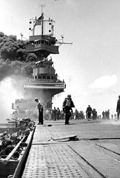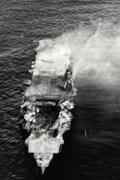
 Carrier Yorktown after dive-bombing attack |
The Battle of Midway remains one of the most important fleet encounters in history. Fought from 4-7 June, 1942, the battle marked the high-water mark of Japanese expansion during the Second World War. Before June 1942, the Imperial Navy had proven an unstoppable juggernaut, crushing the Allies' naval squadrons throughout the Pacific seemingly at will. Japan's naval aviation force, centered on six large fleet carriers, was seemingly invincible. After the battle, and the stunning loss of the Imperial Navy's four finest carriers — Akagi, Kaga, Hiryu, and Soryu — the Japanese would never again be able to reclaim the strategic initiative in the war they had launched in December 1941. The battle was initiated by Admiral Yamamoto Isoroku, commander in chief of Japan's Combined Fleet. Yamamoto, bitterly regretting the absence of the U.S. Navy's fleet carriers at Pearl Harbor, and stung by the famous Doolittle Raid against Tokyo in April, 1942, was determined to annihilate his opponents in a decisive battle somewhere in the central Pacific. The location he selected was the tiny atoll of Midway, some 1,100nm northwest of Oahu. By attacking this apparently strategic outpost of Hawaii, he hoped to lure the American carriers to battle, and then crush them. In the event, Yamamoto got rather more than he bargained for. The Americans, having broken Japan's naval codes, were able to discern enough of Japanese intentions that they had time to organize a hasty defense. Adm. Yamamoto's counterpart, the savvy, aggressive Admiral Chester Nimitz, was determined to fight, not from desperation, but in a cooly calculated bid to destroy Japan's carrier force (known as Kido Butai). As a result, three American flattops — Yorktown, Enterprise, and Hornet — were waiting for Kido Butai when it appeared off Midway on the morning of 4 June. The resulting battle, through many twists and turns, eventually saw the tactical initiative pass from the Japanese to the Americans. And despite the latter's inability to conduct air operations with anything like the level of coordination of the Japanese, three of their dive-bomber squadrons succeeded (with a healthy dose of luck) in finding and attacking three of Japan's four carriers at around 1020AM on the 4th. Within minutes, Akagi, Kaga, and Soryu had been rendered inoperational, doomed to sink. And while Japanese counterstrikes from Hiryu damaged the Yorktown heavily, Japan's last carrier, too, was smashed by the Americans later in the day. Thus, despite Yorktown's eventual demise at the hands of a Japanese submarine a couple days later, the battle was a dramatic triumph for the U.S. — the first clearcut victory after months of defeat at the hands of the Japanese. With carrier power now restored to a level of rough parity between the U.S. and Japan, the door was open for the Americans to initiate operations of their own, the first being the counteroffensive at Guadalcanal in August, 1942. The American triumph at Midway may not have changed the course of the war overnight, but it pointed the way towards an eventual American victory. By the same token, defeat at Midway signaled the end of Japanese naval supremacy, and initiated a cycle of attrition that would eventually see the near-total annihilation of the Imperial Fleet.
|
 Carrier Hiryu, 5 June |
|
Home - The Battle - Myths - Reviews - The Authors - News - Contact - Purchase |